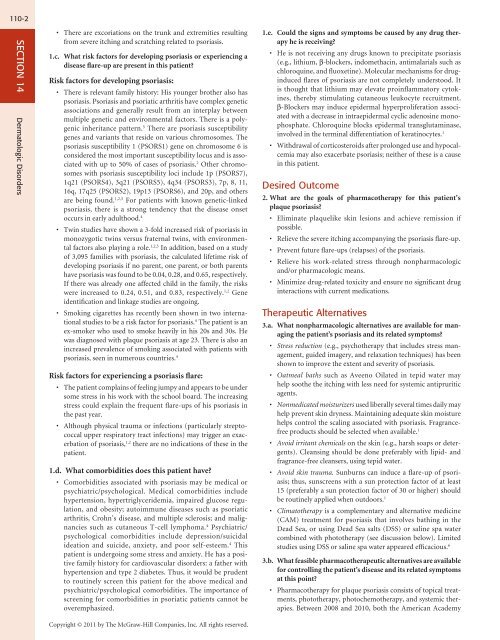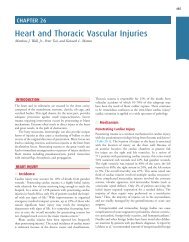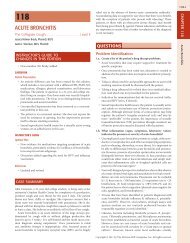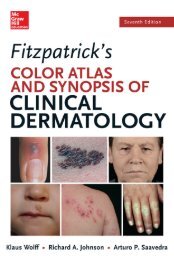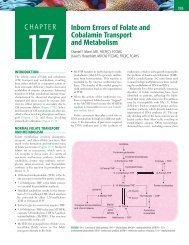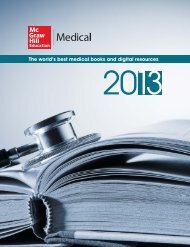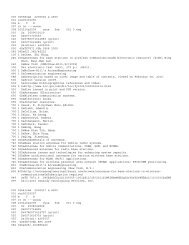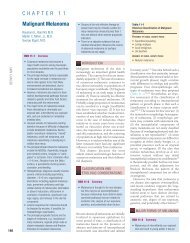PSORIASIS - McGraw-Hill Professional
PSORIASIS - McGraw-Hill Professional
PSORIASIS - McGraw-Hill Professional
Create successful ePaper yourself
Turn your PDF publications into a flip-book with our unique Google optimized e-Paper software.
110-2<br />
SECTION 14 Dermatologic Disorders<br />
• There are excoriations on the trunk and extremities resulting<br />
from severe itching and scratching related to psoriasis.<br />
1.c. What risk factors for developing psoriasis or experiencing a<br />
disease flare-up are present in this patient?<br />
Risk factors for developing psoriasis:<br />
• There is relevant family history: His younger brother also has<br />
psoriasis. Psoriasis and psoriatic arthritis have complex genetic<br />
associations and generally result from an interplay between<br />
multiple genetic and environmental factors. There is a polygenic<br />
inheritance pattern. 5 There are psoriasis susceptibility<br />
genes and variants that reside on various chromosomes. The<br />
psoriasis susceptibility 1 (PSORS1) gene on chromosome 6 is<br />
considered the most important susceptibility locus and is associated<br />
with up to 50% of cases of psoriasis. 2 Other chromosomes<br />
with psoriasis susceptibility loci include 1p (PSORS7),<br />
1q21 (PSORS4), 3q21 (PSORS5), 4q34 (PSORS3), 7p, 8, 11,<br />
16q, 17q25 (PSORS2), 19p13 (PSORS6), and 20p, and others<br />
are being found. 1,2,5 For patients with known genetic-linked<br />
psoriasis, there is a strong tendency that the disease onset<br />
occurs in early adulthood. 4<br />
• Twin studies have shown a 3-fold increased risk of psoriasis in<br />
monozygotic twins versus fraternal twins, with environmental<br />
factors also playing a role. 1,2,5 In addition, based on a study<br />
of 3,095 families with psoriasis, the calculated lifetime risk of<br />
developing psoriasis if no parent, one parent, or both parents<br />
have psoriasis was found to be 0.04, 0.28, and 0.65, respectively.<br />
If there was already one affected child in the family, the risks<br />
were increased to 0.24, 0.51, and 0.83, respectively. 1,2 Gene<br />
identification and linkage studies are ongoing.<br />
• Smoking cigarettes has recently been shown in two international<br />
studies to be a risk factor for psoriasis. 4 The patient is an<br />
ex-smoker who used to smoke heavily in his 20s and 30s. He<br />
was diagnosed with plaque psoriasis at age 23. There is also an<br />
increased prevalence of smoking associated with patients with<br />
psoriasis, seen in numerous countries. 4<br />
Risk factors for experiencing a psoriasis flare:<br />
• The patient complains of feeling jumpy and appears to be under<br />
some stress in his work with the school board. The increasing<br />
stress could explain the frequent flare-ups of his psoriasis in<br />
the past year.<br />
• Although physical trauma or infections (particularly streptococcal<br />
upper respiratory tract infections) may trigger an exacerbation<br />
of psoriasis, 1,2 there are no indications of these in the<br />
patient.<br />
1.d. What comorbidities does this patient have?<br />
• Comorbidities associated with psoriasis may be medical or<br />
psychiatric/psychological. Medical comorbidities include<br />
hypertension, hypertriglyceridemia, impaired glucose regulation,<br />
and obesity; autoimmune diseases such as psoriatic<br />
arthritis, Crohn’s disease, and multiple sclerosis; and malignancies<br />
such as cutaneous T-cell lymphoma. 4 Psychiatric/<br />
psychological comorbidities include depression/suicidal<br />
ideation and suicide, anxiety, and poor self-esteem. 4 This<br />
patient is undergoing some stress and anxiety. He has a positive<br />
family history for cardiovascular disorders: a father with<br />
hypertension and type 2 diabetes. Thus, it would be prudent<br />
to routinely screen this patient for the above medical and<br />
psychiatric/psychological comorbidities. The importance of<br />
screening for comorbidities in psoriatic patients cannot be<br />
overemphasized.<br />
1.e. Could the signs and symptoms be caused by any drug therapy<br />
he is receiving?<br />
• He is not receiving any drugs known to precipitate psoriasis<br />
(e.g., lithium, β-blockers, indomethacin, antimalarials such as<br />
chloroquine, and fluoxetine). Molecular mechanisms for druginduced<br />
flares of psoriasis are not completely understood. It<br />
is thought that lithium may elevate proinflammatory cytokines,<br />
thereby stimulating cutaneous leukocyte recruitment.<br />
β-Blockers may induce epidermal hyperproliferation associated<br />
with a decrease in intraepidermal cyclic adenosine monophosphate.<br />
Chloroquine blocks epidermal transglutaminase,<br />
involved in the terminal differentiation of keratinocytes. 1<br />
• Withdrawal of corticosteroids after prolonged use and hypocalcemia<br />
may also exacerbate psoriasis; neither of these is a cause<br />
in this patient.<br />
Desired Outcome<br />
2. What are the goals of pharmacotherapy for this patient’s<br />
plaque psoriasis?<br />
• Eliminate plaquelike skin lesions and achieve remission if<br />
possible.<br />
• Relieve the severe itching accompanying the psoriasis flare-up.<br />
• Prevent future flare-ups (relapses) of the psoriasis.<br />
• Relieve his work-related stress through nonpharmacologic<br />
and/or pharmacologic means.<br />
• Minimize drug-related toxicity and ensure no significant drug<br />
interactions with current medications.<br />
Therapeutic Alternatives<br />
3.a. What nonpharmacologic alternatives are available for managing<br />
the patient’s psoriasis and its related symptoms?<br />
• Stress reduction (e.g., psychotherapy that includes stress management,<br />
guided imagery, and relaxation techniques) has been<br />
shown to improve the extent and severity of psoriasis.<br />
• Oatmeal baths such as Aveeno Oilated in tepid water may<br />
help soothe the itching with less need for systemic antipruritic<br />
agents.<br />
• Nonmedicated moisturizers used liberally several times daily may<br />
help prevent skin dryness. Maintaining adequate skin moisture<br />
helps control the scaling associated with psoriasis. Fragrancefree<br />
products should be selected when available. 1<br />
• Avoid irritant chemicals on the skin (e.g., harsh soaps or detergents).<br />
Cleansing should be done preferably with lipid- and<br />
fragrance-free cleansers, using tepid water.<br />
• Avoid skin trauma. Sunburns can induce a flare-up of psoriasis;<br />
thus, sunscreens with a sun protection factor of at least<br />
15 (preferably a sun protection factor of 30 or higher) should<br />
be routinely applied when outdoors. 1<br />
• Climatotherapy is a complementary and alternative medicine<br />
(CAM) treatment for psoriasis that involves bathing in the<br />
Dead Sea, or using Dead Sea salts (DSS) or saline spa water<br />
combined with phototherapy (see discussion below). Limited<br />
studies using DSS or saline spa water appeared efficacious. 6<br />
3.b. What feasible pharmacotherapeutic alternatives are available<br />
for controlling the patient’s disease and its related symptoms<br />
at this point?<br />
• Pharmacotherapy for plaque psoriasis consists of topical treatments,<br />
phototherapy, photochemotherapy, and systemic therapies.<br />
Between 2008 and 2010, both the American Academy<br />
Copyright © 2011 by The <strong>McGraw</strong>-<strong>Hill</strong> Companies, Inc. All rights reserved.


